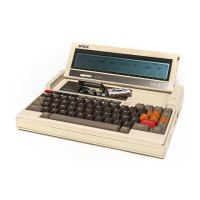SWITCHING
THE
PX-8 ON
As can be seen from the above explanation, when the PX-8
is
switched on, a
number
of
routes can be taken by the operating system.
If
the power was
switched
off
in the continue mode, operation will continue
at
the point at which
it was switched off.
If
the PX-8 was simply switched
off
in the restart mode,
there are a number
of
options possible. These also vary with the way the com-
puter
is
switched
on
(Le. manually
or
under the control
of
the PX-8).
In
order
to understand these possible situations,
an
overview
of
the operating system
is
necessary. However,
to
keep the information together for reference, the fol-
lowing summary
of
what can happen when the PX-8
is
switched
on
is
given
at this point, even though some
of
the concepts have not been covered
at
this
stage in the Manual.
i)
If
the Password has been set the PX-8 will ask for the Password
to
be
en~
teredo
It
will not be possible
to
operate the system any further without en-
tering the correct Password.
ii)
If
the PX-8 has been switched
off
in the continue mode, the program which
was being used, will continue at the point it had reached when the PX-8
was
switched off. Thus if the program was waiting for input, or
was
process-
ing information, this would continue.
iii)
If
the PX-8 was switched
off
in the restart mode, either the MENU page
or the
CP/M
command line would be displayed.
iv)
If
BASIC was in use when the PX-8 was switched off, it
is
possible
to
re-
enter BASIC.
If
the MENU
is
switched on, this
is
done simply by pressing
the
I
RETURN
I key.
If
the MENU
is
switched off, it would appear not
to
be present.
It
can be retrieved (see the SAVE command in Chapter 3), but
you may not remember that you were using BASIC.
It
is
wise to set the
MENU
on
before switching
off
when using BASIC, so that it
is
evident
that BASIC was in use, and
to
prevent any loss
of
programs stored in the
five program areas.
IF YOU SWITCH
THE
COMPUTER ON AND NO DISPLAY APPEARS:
First check that the view angle
of
the LCD
is
set so that you can
see
the screen
display.
If
there
is
still no display, the battery needs recharging. Plug in the AC charg-
er, wait a few seconds and then switch
on
again.
2-20
2.2.3 The PX-8 operating system modules
The operating system
of
the PX-8
is
functionally divided into several units which
are referred to
as
modules. Some
of
them are part
of
the
CP/M
operating sys-
tem and others supplement it.
i) System Display module
This module enables the microcassette tape
to
be operated manually and
also
to
check and reset some
of
the system parameters. This module can
normally be operated while applications software
is
running. Many
of
the
following modules have parameters which can be changed by using this
module.
ii) Password module
This module makes it possible
to
stop unauthorised users from using the
PX-8 without knowing an entry password.
iii) MENU module
This module displays program files and data files
on
the screen and makes
it easier for the user
to
run any program file by selecting it
on
the screen,
using the cursor keys rather than having it to type the full name.
iv) Screen dump module
This module
is
used
to
make a copy
of
the current screen
on
a printer.
v)
Console Command Processor (CCP)
This
is
the part
of
the
CP/M
operating system which interprets command
strings typed
on
the keyboard. This module includes the
CP/M
built-in
commands (DIR, TYPE, REN, ERA, SAVE and USER).
vi) Basic Disk Operating System (BDOS)
This
is
the part
of
the
CP/M
operating system which manages disk files.
It
also treats the ROM capsule and RAM as disk devices.
vii) Microcassette Tape Operating System (MTOS)
This module manages microcassette tape files.
viii) Basic
Input/Output
System (BIOS)
This part
of
CP/M
which acts as the interface between the operating sys-
tem and
input/output
devices e.g. the screen, keyboard and RS232 in-
terface.
ix) Microcassette
Input/Output
System (MIOS)
110
interface between MTOS and microcassette firmware
x)
Clock module
This module controls the alarm and wake functions and updates any time
displays.
xi) System activator
This module controls system activation, deactivation, the auto-start func-
tion and initialization.
2-21

